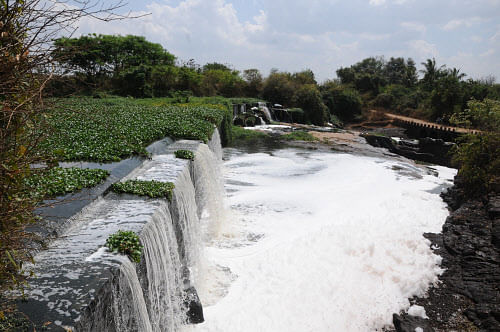
The Lower Subansiri hydro- electric project at Gerukamukh on the Assam-Arunachal border is incurring a daily loss of Rs 10 crore after anti-dam activists of Assam raised safety-related issues.
The 2000-MW project in the Subansiri river, the largest in the country and being executed by the NHPC, has run into rough weather after the work for the project came to a halt in December, 2011.
The height of the dam was initially planned for 257 metres, but later it was reduced to 116 metres after the anti-dam activists under the banner of Krishak Mukti Sangram Samiti in Assam protested.
The protesters, led by KMSS president Akhil Gogoi, contend that the dam will have adverse impact on the people living downstream and the flora and fauna.
"We are incurring a loss of Rs three crore per day as the machines and other equipment are lying idle and have already started rusting. The project, which was supposed to be commissioned in March, this year, is incurring a loss of another Rs seven crore per day against revenue generation," Executive Director of the project Rakesh told a group of visiting journalists.
Already more than 55 per cent work of the project has been completed including tunnel, dam, power house and other civil work.
Machines could be seen lying scattered at the project site while most of the workers have been withdrawn from the project site following suspension of work since 2011.
Though the initial estimated cost of the project was Rs 6,285 core (2002-2005), the project authority has already invested Rs 6,600 crore. The cost of the project now has gone up by Rs 1,200 crore.
Beside this, there was a recurring expenditure of Rs 50 crore per month.
"Any more delay will further escalate the cost of the project which will ultimately affect the people in terms of higher cost of electricity as the continuing delay is only adding to the final cost of power," Rakesh pointed out.
He said the apprehension expressed by the anti-dam protesters were ill-founded since it was by no means a mega dam project, but a run-of-the river project with small reservoirs where 10 per cent of the rain water would be stored while the rest would flow downstream.
"Ten per cent of the water will be accumulated by the project while 90 per cent will flow without having any effect on the flow of the river through specifically designed eight surge tunnels," the executive director explained.
"Initially the project was designed by the Brahmaputra Board as a flood control project which did not materialize since it had the potential to submerge important towns like Daporijo, Dumporijo and Tamen in Arunachal Pradesh. Later, it was designed as a hydro project along with flood moderation project," Rakesh said.
It was basically a value addition to flood protection measures in the downstream, he further said.
The lower Subansiri project is an initiative of the Arunachal Pradesh government as part of its decision to tap 50,000 MW power potential in the state.
The river which originates at China, is around 287 km from the source. The state government has planned two more projects in the river namely Upper Subansiri with an installed capacity of 2,000 MW (dam height 135 metres) and Middle Subansiri (dam height 200 meters) with installed capacity of 1,600 MW power.
As the Brahmaputra River is situated at a distance of 90 Km from the Lower Subansiri dam, the impact downstream would be concentrated to only 30 km and beyond that there will be no impact, according to a study carried out by the Central Water Commission.
To compensate for this, the NHPC authorities have already paid an amount of Rs 70 crore to 78 families from Gensi and Sebrity villages under West Siang district in Arunachal Pradesh who voluntarily agreed to shift, as the villages are likely to be submerged after construction of the dam.
The reservoir of the Subansiri Project will submerge a 47 km length of the Subansiri river and destroy 34 square km which includes Himalayan subtropical pine forests, Himalayan subtropical broadleaf forests, part of the Tale Valley Wildlife Sanctuary, an elephant corridor and some subsistence agriculture fields.
"A total 34 sq km area inside Arunachal Pradesh will be affected (mostly forest area) by the project which is very minimal," Chief Engineer R K Chaudhary pointed out.
He said the NHPC had already paid an amount of Rs 300 crore to compensate for the forest loss as Net Present Value (NPV) in 2004.
Moreover, he said, an amount of Rs 86 crore and 16 crore was paid to the forest departments of Arunachal and Assam respectively for undertaking compensatory afforestation.
"For catchment area treatment plan, we have paid Rs eight plus crore to the Arunachal Pradesh government," Chaudhury said.
On the power share from the project for Arunachal Pradesh and Assam, Chaudhury said that out of the 12 per cent free power, Arunachal would get 10.75 per cent (240 mw) and additional 1.1 per cent free power for local area development, while Assam would get 1.25 per cent mw (25 mw) power.
"In addition, Assam will get 208 MW (Purchasable power) along with 300 MW power from central sector which comes to 533 MW power from this project," Chaudhury informed.
He said eight machines with 300 cumecs discharge capacity and producing capacity of 250 mw power each would run in the morning and evening during monsoon while, during lean season one unit would run continuously for 24 hours.
"During flood season about 12000 to 13000 cumecs of water will be discharged in the river while 6000-7000 cumecs will be released in order to keep the water level of the river normal," the chief engineer said when asked on the impact of aquatic faunas in the downstream river.
He said efforts were also taken to develop hatchery for fish management plan besides biological and engineering measures planned by constructing check dams for catchment area treatment.